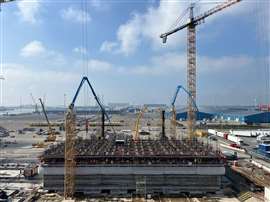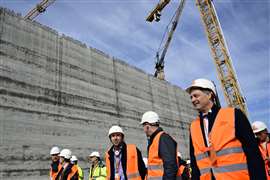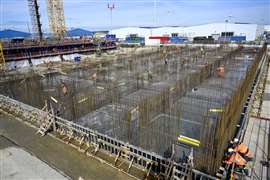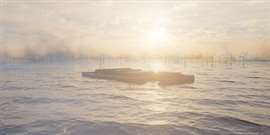Building the massive foundations for a $3.9bn North Sea artificial island
01 October 2024
 Work at the TM Edison fabrication yard in Vlissingen, the Netherlands. Photo: AMCS
Work at the TM Edison fabrication yard in Vlissingen, the Netherlands. Photo: AMCS
Contractors have started building the foundations for what will become the world’s first ‘energy island’ – a multi-billion-Euro artificial island in the North Sea that will gather the electricity produced by the growing number of offshore wind turbines in the area and send it to shore in a more cost-effective and efficient way. Lucy Barnard finds out how the foundation for the six-hectare island (the size of 12 soccer fields) is being built.
At a fabrication yard in Vlissingen, in the Netherlands, workers employed by a joint venture between Belgian construction contractor Jan de Nul and dredging specialist DEME are busy building huge reinforced concrete caissons.
Each of the 23 massive, cuboid caissons that the TM Edison joint venture is constructing is 57 metres long, 30 metres high and 30 metres wide. The size of a 10-storey building and weighing 22,000 tonnes, every caisson takes a team of 300 people three months to build.
Gradually, the 23 structures will be floated out to sea by tugboat to a spot around 45 kilometres off the coast of Ostend, Belgium, where they will form the outer walls for the foundations of a huge new ‘energy island’ designed to make the generation of offshore wind power in the North Sea more efficient.
The island, which will be known as Princess Elisabeth Island, will act as a sort of mega electricity sub-station, connected to the growing number of wind farms in the North Sea. Its construction, for Belgian utility company Elia, will cost a reported €3.6 billion (US$3.9 billion). The aim behind it is to help reduce Europe’s reliance on fossil fuels, at the same time curbing its reliance on natural gas, which was exposed by Russia’s invasion of Ukraine in 2022.
Speaking to reporters earlier this year, Belgium’s outgoing prime minister Alexander de Croo said, “The North Sea is set to become the powerhouse of our energy independence, and Princess Elisabeth Island will be a crucial part of this process. Belgium has long been a pioneer in offshore wind, and by continuing to innovate, we are further consolidating our position for the future.”
 Outgoing Prime Minister Alexander De Croo (R) pictured during a visit to the construction site of the ‘Prinses Elisabeth Eiland - energy island in the North Sea in Vlissingen, the Netherlands. Photo: Belga Photo Dirk Waem/Reuters.
Outgoing Prime Minister Alexander De Croo (R) pictured during a visit to the construction site of the ‘Prinses Elisabeth Eiland - energy island in the North Sea in Vlissingen, the Netherlands. Photo: Belga Photo Dirk Waem/Reuters.
Challenging construction
“Princess Elisabeth Island will be the world’s first artificial energy island that combines both direct current and alternating current,” says Jan Fordeyn, director of project development and conceptual design at Jan de Nul.
“The island’s high voltage infrastructure will bundle the wind farm export cables of the Princess Elisabeth zone together, whilst also serving as a hub for future interconnectors with Great Britain and Denmark. The island will be the first building block of an integrated European offshore electricity grid.”
Building such an island in the North Sea brings its own challenges, however.
“The use of caissons in a marine infrastructure design is not as common in the North Sea region as it is in the Mediterranean,” Fordeyn admits. “This means all the parties involved from suppliers to certifying agencies are confronted with aspects that are new to them.”
Ensuring that as much of the complicated construction work takes place on land, at TM Edison’s specially designed fabrication yard, is part of an effort to reduce the risks and costs associated with building in such a remote spot.
First concrete is poured to create the massive, reinforced bases for the caissons before the cured base plates are moved on runners to a second station. Here a sliding formwork structure is set up to build the walls and concrete is continuously poured into the huge moulds for around ten days, slowly rising to build the enormous walls at a rate of ten centimetres every hour using electrically powered concrete pumps from German pump manufacturer Putzmeister.
Fordeyn explains, “At peak times around 400 people per shift will be working on the construction site – making it approximately 800 people a day. A variety of specialisations are required for the project. These include steel fixers for reinforcement, formwork and concrete labourers, crane operators, welders and electricians.”
After this, the partly formed caissons are then slowly moved on runners to a third workstation where cable entries are added, followed by a further stop where a reinforced concrete roof is added and eventually storm walls.
Construction of each caisson takes about 85 days but TM Edison’s facility allows five caissons to be produced at the same time. In total about 165,000 cubic meters of concrete will be poured into the caissons.
The project is subject to a tight schedule. Work began in September 2023 and the caissons should be sunk into position throughout this summer, weather permitting. “Setting up a complete construction yard in less than six months has been one of the biggest challenges so far,” says Fordeyn.
Sinking the caissons
Tugboats will take the partially submerged caissons out to their final location at sea, once they are fully cured. Dredging vessels will partially fill the inside of the caissons with sand, which will cause them to sink further and take up their final position on the seabed. The seabed itself will already have been levelled out by suction hopper dredgers, ahead of rubble being placed on the seabed to form a solid foundation for the caissons.
Once all 23 caissons are in place to form the outer wall of the energy island’s foundation, TM Edison will use dredgers to fill the core of the island with sand, compacting it using vibro-flotation. Dredgers will also place large amounts of rock around the caissons for toe protection and scour protection in the event of stormy conditions.
A small harbour and helipad required for maintenance visits will then be installed, once the main structure of the island is complete.
Substation installation
Following completion of the foundation towards the end of this year, installation work on the island is set to take place from May 2025 until the beginning of 2029.
Smulders, a Belgian subsidiary of French contractor Eiffage, and Dutch specialist HSM Offshore Energy, have the responsibility of designing, manufacturing, installing and commissioning four alternating current electrical substations on the island. Two of those will be 1,050-megawatt substations.
 Formwork construction taking place in the Vlissingen fabrication yard. Photo: Belga Photo Dirk Waem/Reuters
Formwork construction taking place in the Vlissingen fabrication yard. Photo: Belga Photo Dirk Waem/Reuters
Like the foundations, the installation work on the island involves as much offsite fabrication as possible, in a bid to reduce the time and manpower required for the final assembly in a remote spot in the North Sea.
Marguerite Richebé, media relations officer at Eiffage, explains, “The majority of the current scope [of the work] is onshore in the Smulders production facility at Vlissingen and the HSM facility in Schiedam.
“The modules will be outfitted to the maximum extent possible to limit the works on the island.”
TM Edison and Elia are working to make the remote location more hospitable for the workers who are required offshore during the installation phase next year, according to Fordeyn.
“Shifts typically last for 12 hours for offshore workers,” he says. “During their time off on board the installation vessels there is good catering and a gym, video games and a multi-media movie system for entertainment. Also internet is provided so that offshore colleagues can keep in touch with friends and family.”
More energy islands to come
As things stand today, offshore wind farms in the North Sea send the power they generate to onshore energy grids via their own dedicated cables. The Princess Elisabeth energy island aims to gather together electricity from several wind farms all at once, and send it onshore through one large cable in a cheaper and more efficient manner. Energy islands could also feed power to multiple countries based on demand.
European countries are pledging to build dozens of new wind farms in the North Sea, multiplying total capacity from around 30 gigawatts today, to 120 gigawatts by 2030 and 300 gigawatts by 2050 – enough to power every home on the continent.
With that growth will come the need for an improved electrical infrastructure to distribute that power.
 An artist’s impression of the completed project. Image: Elia
An artist’s impression of the completed project. Image: Elia
That means that TM Edison and its competitors are predicting more energy island construction work in the future.
“We believe it is a matter of time before other energy islands are built,” says Fordeyn. “The North Sea has favourable conditions for islands. It is relatively shallow and there is a lot of infrastructure to be accommodated.”
The Danish Parliament approved the design and construction of a 3 gigawatt artificial energy island in 2021. Located in the North Sea, 80 kilometres west of Jutland, it would be more than twice the size of Princess Elisabeth island if constructed. But a tender to build it has been postponed due to the high anticipated costs of building it and the Danish government is now thought to be looking at cheaper options such as potentially building a platform on piles.
Dutch grid operator TenneT alongside its German subsidiary and Danish power company Energinet, is also working up plans for a proposed six-square-kilometre energy island complex known as the North Sea Wind Power Hub, located in the Dogger Bank area between the territorial waters of the UK, Germany, the Netherlands and Denmark. Shallow waters in the area make it suitable for traditional fixed foundation wind turbine designs, which are limited to depths of 40 metres to 50 metres.



